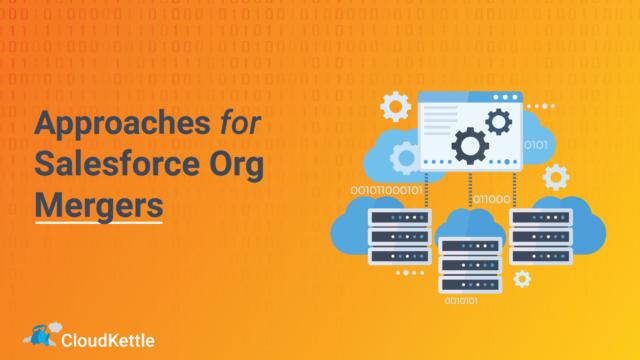Imagine this scenario: Two separate companies have heavily customized Salesforce orgs that work perfectly for their own respective business needs. Then, one company acquires the other company.
Overview
The Two Approaches
Lift-and-Shift
Move-and-Improve (Optimization)
The Third Rail
It Isn’t Just Salesforce
How CloudKettle Can Help
What happens next?
That’s a great question – and a situation that’s more and more common these days as Salesforce continues to dominate the CRM landscape at both the SMB and Enterprise level. In the case of an acquisition, there are clear benefits to merging orgs and combining data into a single source of truth.
- Users in all business units are able to see a 360-degree view of the customer in one place; cross-selling and upselling become more effective and more frequent
- Greater ease in onboarding and training new users on a unified system
- Standardized processes help eliminate guesswork and increase data quality
- Lower cost (both time and money) to maintaining a single org vs multiple orgs, especially given the frequency with which Salesforce releases critical updates and new features
- Reduction in maintenance and subscription costs from fewer duplicate or competing solutions once a single org is in place
However, while an org merger may be the end goal, it is not to be rushed. Careful consideration and analysis should be undertaken before a merge begins.
- An org merger requires significant investment in planning, training and change management (especially for users of the retiring org)
- In an effort to standardize processes across business units, there may be additional considerations when building components automations in Salesforce
- With org mergers, the surviving Salesforce org will reach data limits faster, and there is an increased possibility of hitting governor limits
- Mergers can seldom be done effectively internally, because team members are at capacity in their existing roles and not experienced in the nuances of this type of large scale project. Timelines and budgets need to reflect those realities
At this point, it is important to note that while the term “Merger” is often used, there is no true way to merge a Salesforce org and related ecosystem. One (or both in the case of a new or “greenfield” deployment) of the legacy orgs is retired. Which org should be retired is also something that should be considered carefully. It is often the case that the org of the smaller (often younger and more nimble) acquisition is superior and more advanced than that of the parent company and is a better option to move forward with/preserve.
The Two Approaches.
Salesforce Org Mergers are complex projects involving significant time and resources. The org that is being merged into is known as the ‘surviving’ org and the org that is being offboarded is known as the ‘retiring’ org. The two most common approaches to a Salesforce org merger are ‘lift-and-shift’ and a ‘move-and-improve’ (or optimization).
Lift-and-Shift
With a lift-and-shift approach, metadata and data are brought over mainly ‘as-is.’ The goal of this type of migration is to minimize the time it takes to onboard the retiring org users to the surviving org. Although this approach has short-term time benefits, it creates significant technical debt and increases maintenance and long-term ownership costs of the system. For example, duplicate fields that serve the same purpose, duplicated automation, and increased difficulty in troubleshooting.
This process involves creating record types on all objects in both the retiring and surviving orgs, updating all references to the objects (data, page layouts, lightning record pages, automation, formula fields, integrations, etc.) in the orgs, and then migrating components from the retiring org to the surviving org. While the implementation effort and timeline are simpler than an optimized migration, the maintenance of two business processes becomes very complex.
With this approach, an organization does not take advantage of two key benefits of executing a Salesforce org merger: reduction in maintenance cost and effort and removal of silos across business units.
Move-and-Improve (Optimization)
An optimization approach can also be considered a ‘move-and-improve.’ With this approach, the goal is to make the new org and its business processes as efficient as possible. One way this is achieved is to design and build a new process that incorporates the best of both processes, instead of the two processes of the ‘surviving’ and ‘retiring’ org co-existing. Alternatively, an organization can use a single, standardized process and leverage its change management capabilities to fill gaps between the retiring and surviving orgs.
Executing an org merger through an optimization approach helps the organization understand roadblocks and inefficiencies in current processes.
“It forces end-users and leadership to think about the parts of their business, integrations and technical processes that would become overburdened by scaling the number of users who use that process.”
For example, a Salesforce org struggling with issues of large data volumes or inefficient code will only struggle more with the addition of new users, migration of data and increased customization.
The optimization approach helps deliver the benefits of an org merger without the downfalls of a lift-and-shift approach. Maintenance costs are significantly reduced through unified processes, reduction of technical debt brought into an org, and the metadata cleanup of the surviving org to be better equipped to ingest another Salesforce org.
The Third Rail
There is a third possible path often initially favored by Salesforce Admins struggling to maintain an existing org, which is a Greenfield deployment. In this scenario, both orgs are retired and a single unified process and ecosystem of integrations migrated to a newly deployed Salesforce org. Although a fresh start like this may seem desirable, of the three options, this path is rarely recommended by CloudKettle as it is the slowest path and the one most likely to have cost and time overruns. Any large scale project like this has risks, but the Greenfield path carries substantially more than the other two options.
It isn’t just Salesforce
An important thing to keep in mind is that Salesforce is rarely an island unto itself. Most orgs are integrated with five, ten, fifteen (or more) core business systems like Marketing Automation, enrichment, data warehouses, proprietary backend databases, accounting – the list goes on. A move to merge Salesforce orgs means considering those other platforms; including their stakeholders in the process upfront will help prevent issues closer to the deployment date.
How CloudKettle Can Help
CloudKettle is participating in multiple merger and migration projects at any given time. As you consider or plan for a merger, get in touch. We are happy to discuss your needs and walk you through key areas of consideration that will help you de-risk your project and increase your likelihood of success. Have questions or just want to talk about Salesforce? Get in Touch.



